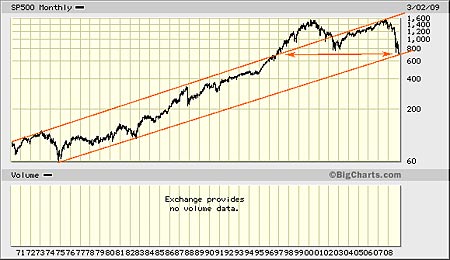
It is a characteristic of bull markets that sell-offs are short, sharp, violent and bigger-than-expected – so much so that people question whether the bull market is still intact.
The same applies to bear markets, only in reverse. You get these sudden, short-covering spikes up as traders who’ve been betting on falls rush to cover their positions. These spikes – if timed well – can be good money-making opportunities for those who have the spare cash to dabble in short-term trades.
I think we could be reaching one such opportunity – and it could come as soon as Thursday. Here’s why…
Why we should be expecting a bounce
Here is a long-term, log chart of the S&P. As you can see by the red trend lines, there is a clear, long-term channel in place. We have come back to the lower line of the channel. That is, technically, a likely place to find a bottom.
As trader Michael Hampton of Global Edge Investors observes, what is interesting is that we have also retraced to the levels of late 1996 when the S&P broke out above that long-term channel. The markets have come back to ‘revisit the scene of the crime’.
What crime though? What happened in late 1996? Well, it’s worth noting that this break-out came just a month before Alan Greenspan’s famous ‘irrational exuberance’ speech of December 5th, 1996, when he said: “How do we know when irrational exuberance has unduly escalated asset values, which then become subject to unexpected and prolonged contractions as they have in Japan over the past decade? And how do we factor that assessment into monetary policy? We as central bankers need not be concerned if a collapsing financial asset bubble does not threaten to impair the real economy, its production, jobs, and price stability. Indeed, the sharp stockmarket break of 1987 had few negative consequences for the economy.”
Despite the warning in that speech, Greenspan did nothing to rein in credit growth – the credit growth which resulted in the greatest debt bubble of all time, the consequences of which we are all now suffering. And in fact, that break-out above the long-term trend-line marked the beginning of the era when the banks began to outperform the general markets – the era of cheap credit – an era which ended on February 26th 2007, when the banks began to underperform. It was the era of monetary irresponsibility. The stockmarkets have now lost all the gains that were made.
So that’s one reason to expect a bounce – we are at a nice technical level at which to find a low.
Why else should it come now? Well, bearish sentiment is now overwhelming and everywhere. It has flooded the mainstream. One example came yesterday when Max Hastings wrote in the Daily Mail: “The stability and political fabric of entire societies are imperilled by the meltdown of capitalism’s institutions”. Sentiment doesn’t get much more bearish than that.
Is the US dollar at a new high?
It’s also possible that the US dollar is making a fresh high. In recent years, the dollar has risen as stockmarkets have fallen and has fallen as stockmarkets have rallied. Rarely have the two risen or fallen in unison. In last week’s Money Morning (How far will stockmarkets fall?) I wrote about double tops and the reversals they sometimes signify.
It looks like the dollar, the fundamentals of which get worse with every US policy announcement, could be making a double top here at the 89 area, where there is a lot of resistance (see chart below). A reversal in the dollar could signify a reversal in the stockmarkets. (It could also, even though they have been trading together in recent weeks, be bullish for gold).
Can the stars predict share movements?
Lastly, it’s in the stars. I’m not joking. Larry Pesavento is a ‘pattern recognition expert’ from the US. He uses geometric patterns, Fibonacci ratios – and astrology. I would instantly dismiss the last if not for the fact that I listened to his comments on the Tom O’Brien Show throughout October and November last year and he called the markets with frightening accuracy almost to the day. His cycles-work, which I do not pretend to understand, and which, no doubt, you have to sign up for and pay a lot of money to be taught, is also calling for a low later this week.
He said, “I’ve been bearish for a long time. I’ve been bearish since July of ’07. This is the first time I felt bullish. Oil stocks, copper, things like Apple. We could get the mother of all short-covering rallies. We have negative sentiment everywhere. There are very few people that are looking for this. These are astrological patterns and they’re set up.”
If a rally comes, it could be sweet – but this isn’t the bottom yet
So I’m suggesting that this break below the November lows in most major indices is a bear trap – a snare for unwary traders who are still betting the market will fall. We got to the November lows hard and fast, then rallied. This re-test and break below has been a painful, inexorable, but more gradual slide down on lighter volume.
I could be very wrong, of course. It wouldn’t be the first time, and I don’t advise betting the house or anything like it on this. The economic fundamentals couldn’t be worse. But a rally, if it comes, could be short, sharp, sweet – and very painful if you’re on the other side of the market. But remember, this isn’t the bottom – it will only be a trade-able bounce in an ongoing economic disaster.
One more thing: if it does come and it lasts longer than people expect, watch policy-makers rush to take the credit for their ‘handling of the crisis’.